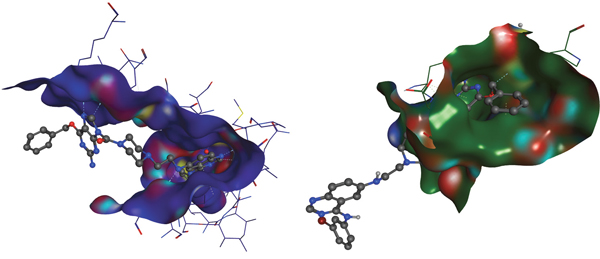The cover for issue 80 of Oncotarget features Figure 5, "Molecular modeling of MR30," by Rupp, et al.
In order to block uncoupled events associated with EGFR and MGMT, the research team designed MR30, a single molecule termed combi-molecule that contains a quinazoline arm targeted to EGFR and an O6-benzylguanine moiety to block MGMT. Molecular analysis of the mechanism of action of its two arms showed that: it could block EGFR phosphorylation, down-regulate the RAF-MAPK and the PI3K-AKT pathways, and covalently modify MGMT through S-benzylation, as confirmed by MALDI analysis of a direct binding assay with isolated MGMT, it induced a dose-dependent down-regulation of MGMT in lung and melanoma cells.
Bertrand J. Jean-Claude from the Cancer Drug Research Laboratory, Department of Medicine, Division of Medical Oncology, at The Research Institute of the McGill University Health Center/Glen Hospital, in Montreal, QC, H4A 3J1, Canada said, "Disordered expression of receptor tyrosine kinases has been associated with resistance to radiation and DNA damaging drugs such as cisplatin and temozolomide , a clinical alkylating agent that induces O6-methyl, N7-methylguanine and N3-methyladenine lesions."
Based on the premise that activation of EGFR leads to induction of DNA repair proteins such as X-ray repair cross-complementing protein 1 and excision repair cross-complementation group 1, the group embarked onto the design of drugs termed combi-molecules that can induce a tandem targeting of EGFR and DNA and demonstrated that indeed the latter dual targeted molecules could down-regulate XRCC1 and ERCC1 through their EGFR inhibitory arm and inducing high levels of DNA strand breaks through their DNA alkylating arm.

Figure 5: Molecular modeling of MR30. Molecular modeling of MR30 in EGFR kinase pocket (blue) and MGMT active site (green). The quinazoline moiety of MR30 is bound to the 1M17 structure (blue) in a pose analogous to erlotinib. In this pose, the MGMT portion and the urea linker of MR30 points out of the ATP binding pocket towards a solvent, allowing for conformational flexibility. The MGMT inhibitory portion of MR30 is in very similar position as O6-BG in 3KZZ (green), and maintained the same protein-ligand non-bonded interactions as O6-BG. The urea linker and the quinazoline portion of MR30 is solvent exposed and made no specific interactions with the MGMT active site.
Using double arm combi-molecules designed to down-regulate EGFR and methylate DNA, they demonstrated that MGMT expression was uncoupled with down-regulation of EGFR signaling. Accordingly, targeting EGFR alone does not lead to down-regulation nor depletion of the function of MGMT. Therefore, here they rationally designed a molecule to block EGFR and MGMT, thereby compensating for the deleterious effects of the uncoupled mechanism of EGFR expression and MGMT expression.
Indeed, the research team previously showed that a single molecule designed to block EGFR and damage DNA could block EGFR phosphorylation and its downstream RAF-MAPK and PI3K-AKT pathways, induce p53 and Bax and ultimately trigger apoptosis in tumour cells. Thus, they designed MR30 to contain a quinazoline arm capable of targeting EGFR and an O6-BG-like moiety to target MGMT, with the premise that such a molecule will be able to target the EGFR-MGMT uncoupled paths by down-regulating EGFR signaling and decreasing MGMT levels.
The Bertrand J. Jean-Claude research team concluded, "Thus, MR30 is a multifaceted molecule, which can be used under multiple contexts: to exert selectivity for the HER family of oncogenes, to induce potent growth inhibition in tumour cells with PTEN, K-RAS, B-RAF mutations and to sensitize tumours that co-express EGFR and MGMT to TMZ. Through its MGMT targeting arm, it can induce S-benzylation and down-regulation of MGMT and potentiation of TMZ in tumour cells co-expressing EGFR and MGMT."
Full text - https://doi.org/10.18632/oncotarget.25120
Correspondence to - Bertrand J. Jean-Claude - [email protected]
Keywords - EGFR, MGMT, combi-molecule, kinase inhibition, combination chemotherapy


